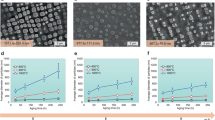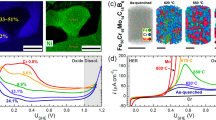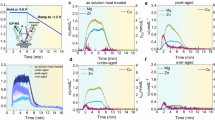Abstract
De-alloying is the selective dissolution of one or more of the elemental components of an alloy. In binary alloys that exhibit complete solid solubility, de-alloying of the less noble component results in the formation of nanoporous metals, a materials class that has attracted attention for applications such as catalysis1, sensing2 and actuation3. In addition, the occurrence of de-alloying in metallic alloy systems under stress is known to result in stress-corrosion cracking4, a key failure mechanism in fossil fuel and nuclear plants5, ageing aircraft6, and also an important concern in the design of nuclear-waste storage containers7. Central to the design of corrosion-resistant alloys is the identification of a composition-dependent electrochemical critical potential, Vcrit, above which the current rises dramatically with potential, signalling the onset of bulk de-alloying8,9. Below Vcrit, the surface is passivated by the accumulation of up to several monolayers of the more noble component. The current understanding of the processes that control Vcrit is incomplete. Here, we report on de-alloying results of Ag/Au superlattices that clarify the role of pre-existing length scales in alloy dissolution. Our data motivated us to re-analyse existing data on critical potentials of Ag–Au alloys and develop a simple unifying picture that accounts for the compositional dependence of solid-solution alloy critical potentials.
This is a preview of subscription content, access via your institution
Access options
Subscribe to this journal
Receive 12 print issues and online access
$259.00 per year
only $21.58 per issue
Buy this article
- Purchase on Springer Link
- Instant access to full article PDF
Prices may be subject to local taxes which are calculated during checkout



Similar content being viewed by others
References
Ding, Y., Chen, M. W. & Erlebacher, J. Metallic mesoporous nanocomposites for electrocatalysis. J. Am. Chem. Soc. 126, 6876–6877 (2004).
Heida, M. et al. Ultrasensitive quartz crystal microbalance with porous gold electrodes. Appl. Phys. Lett. 84, 628–630 (2004).
Kramer, D., Viswanath, R. N. & Weissmuller, J. Surface-stress induced macroscopic bending of nanoporous gold cantilevers. Nano Lett. 4, 793–796 (2004).
Sieradzki, K. & Newman, R. C. Stress-corrosion cracking. J. Phys. Chem. Solids 48, 1101–1113 (1987).
Deakin, J., Dong, Z., Lynch, B. & Newman, R. C. De-alloying of type 316-stainless steel in hot, concentrated sodium hydroxide solution. Corros. Sci. 46, 2117–2133 (2004).
Vukmirovic, M. B., Dimitrov, N. & Sieradzki, K. De-alloying and corrosion of Al alloy 2024-T3. J. Electrochem. Soc. B 149, 428–439 (2002).
Andresen, P. L., Young, L. M., Catlin, G. M., Emigh, P. W. & Gordon, G. M. Stress-corrosion-crack initiation and growth-rate studies on titanium grade 7 and Alloy 22 in concentrated groundwater. Metall. Mater. Trans. A 36, 1187–1198 (2005).
Sieradzki, K., Movrin, D., McCall, C., Dimitrov, N. & Erlebacher, J. The de-alloying critical potential. J. Electrochem. Soc. B 149, 370–377 (2002).
Renner, F. U., Stierle, A., Dosch, H., Kolb, D. M. & Zegenhagen, J. Initial corrosion observed on the atomic scale. Nature 439, 707–710 (2006).
Erlebacher, J., Aziz, M. J., Karma, A., Dimitrov, N. & Sieradzki, K. Evolution of nanoporosity in dealloying. Nature 410, 450–453 (2001).
Erlebacher, J. & Sieradzki, K. Pattern formation during dealloying. Scripta Mater. 49, 991–996 (2003).
Sieradzki, K. Curvature effects in alloy dissolution. J. Electrochem. Soc. 140, 2868–2872 (1993).
Stauffer, D. & Aharony, A. Introduction to Percolation Theory 2nd edn (Taylor and Francis, London, 1991).
Wagner, K., Brankovic, S. R., Dimitrov, N. & Sieradzki, K. Dealloying below the critical potential. J. Electrochem. Soc. 144, 3545–3555 (1997).
McCall, C., Dimitrov, N. & Sieradzki, K. Underpotential deposition on alloys. J. Electrochem. Soc. 148, E290–E293 (2001).
Friesen, C., Dimitrov, N., Cammarata, R. C. & Sieradzki, K. Surface stress and the electrocapillarity of solid electrodes. Langmuir 17, 807–815 (2001).
Wagner, C. & Engelhardt, G. Beiträge zur Kenntnis der thermodynamischen Aktivitäten in binären Legierungen. Z. Phys. Chem. A 159, 241–274 (1932).
Oriani, R. A. Thermodynamics of liquid Ag–Au and Au–Cu alloys and the question of strain energy in solid solutions. Acta Metall. 4, 15–25 (1956).
Needs, R. J. & Mansfield, M. Calculations of the surface stress tensor and surface energy of the (111) surfaces of iridium, platinum and gold. J. Phys. Condens. Matter 1, 7555–7563 (1989).
Feng, Y. J., Bohnen, K. P. & Chan, C. T. First-principles studies of Au(100)-hex reconstruction in an electrochemical environment. Phys. Rev. B 72, 125401 (2005).
Jones, H. The surface energy of solid metals. Met. Sci. J. 5, 15–18 (1971).
Tyson, W. R. & Miller, W. A. Surface free energies of solid metals: estimation from liquid surface tension measurements. Surf. Sci. 62, 267–276 (1977).
Erlebacher, J. An atomistic description of dealloying, porosity evolution, the critical potential and rate-limiting behavior. J. Electrochem. Soc. C 151, 614–626 (2004).
Dursun, A., Pugh, D. V. & Corcoran, S. G. Probing the dealloying critical potential. J. Electrochem. Soc. B 152, 65–72 (2005).
Acknowledgements
This work was supported by the National Science Foundation (DMR-0301007 and CTS-0304062).
Author information
Authors and Affiliations
Corresponding author
Ethics declarations
Competing interests
The authors declare no competing financial interests.
Supplementary information
Supplementary Information
Supplementary information, figures S1-S3 and supplementary references (PDF 238 kb)
Rights and permissions
About this article
Cite this article
Rugolo, J., Erlebacher, J. & Sieradzki, K. Length scales in alloy dissolution and measurement of absolute interfacial free energy. Nature Mater 5, 946–949 (2006). https://doi.org/10.1038/nmat1780
Received:
Accepted:
Published:
Issue Date:
DOI: https://doi.org/10.1038/nmat1780
This article is cited by
-
Formation of three-dimensional bicontinuous structures via molten salt dealloying studied in real-time by in situ synchrotron X-ray nano-tomography
Nature Communications (2021)
-
Decoupling the role of stress and corrosion in the intergranular cracking of noble-metal alloys
Nature Materials (2018)
-
Potential-dependent dynamic fracture of nanoporous gold
Nature Materials (2015)
-
On the self-patterning of islands by mechanical constraints during electrochemical deposition
Applied Physics A (2015)
-
Emerging Science and Research Opportunities for Metals and Metallic Nanostructures
JOM (2014)



